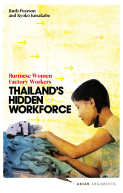Thailand’s Hidden Workforce:
Burmese Migrant Women Factory Workers
Ruth Pearson and Kyoko Kusakabe
 Imagine you’re a teenage girl in rural Burma living in a poor village, with limited access to education, opportunities to earn money and oppressive surroundings. You hear about factory jobs across the border in Thailand. You could support your family, see a bigger world, and also hope to gain some life skills for your future. Many of your friends have already left the village and have invited you to join them.
Imagine you’re a teenage girl in rural Burma living in a poor village, with limited access to education, opportunities to earn money and oppressive surroundings. You hear about factory jobs across the border in Thailand. You could support your family, see a bigger world, and also hope to gain some life skills for your future. Many of your friends have already left the village and have invited you to join them.
In Thailand’s Hidden Workforce: Burmese Migrant Women Factory Workers, Ruth Pearson and Kyoko Kusakabe provide the rich and necessary context for understanding the dynamics young people face in deciding whether to migrate, how to stay safe, how to make life choices and deal with the consequences.
These compelling questions are presented through the perspective of female factory workers from Myanmar in Thailand, and those living and working most closely with them. The book pulls us up on our own assumptions about young female migrant workers being naïve or foolish, by describing how they make calculated and complex decisions based on extremely limited opportunities and resources.
I have worked on migration issues in South-East Asia for over 30 years, and this is the most comprehensive publication on migrant labour in Thailand that I have read. Through effective use of case studies and in-depth analysis of international and national policies, interventions, and attitudes, it helps readers understand the realities and perspectives of migrant workers and provides vital context.
The narrative research reads easily and smoothly, yet the authors do not shy away from the complexities of cultural values, government policies, and global economics. They provide a clear and concise overview of history, dilemmas, and challenges. This book is invaluable to anyone seeking to understand the challenges or seeking to reach out to this population. It is also important for those working in the region, particularly Myanmar and/or Thailand, to be aware of this hidden population, and the impact it has on both the host countries and the families and communities back home. I would recommend this book, as well, to those interested in South-East Asia, or issues surrounding migration/trafficking. Understanding the realities on the ground, based on the perspectives and perceived choices of those migrating, is critical to any successful effort to reach this population. Ignoring their growing numbers and presence throughout Thailand, South-East Asia, and around the world will render all our interventions on the Millennium Development Goals, or any other development effort, ultimately ineffective.
The only weakness of the research is that it did not delve deeply into the perspectives and challenges faced by governments and their key ministries (labour, health, education, immigration, security) in addressing the pressures, dilemmas, and challenges of increasing migration. Indeed there are many within the Thai government who are advocates of migrants’ rights and work toward securing their access to services. It would be very useful to explore further the steps they have taken and what they consider would be effective tactics for bringing about a more just and equitable work, living, and social environment for the growing number of migrants both into and out of their country. Perhaps this is an area for further research as we continue to understand and engage the growing challenges of migration and the impact it has on all of our well-being.
Review ©2013 Thérèse M. Caouette, Partners Asia Thailand’s
Hidden Workforce: Burmese Migrant Women Factory Workers is published by Zed Books
Review originally published in Gender & Development 21.1 (2013)
